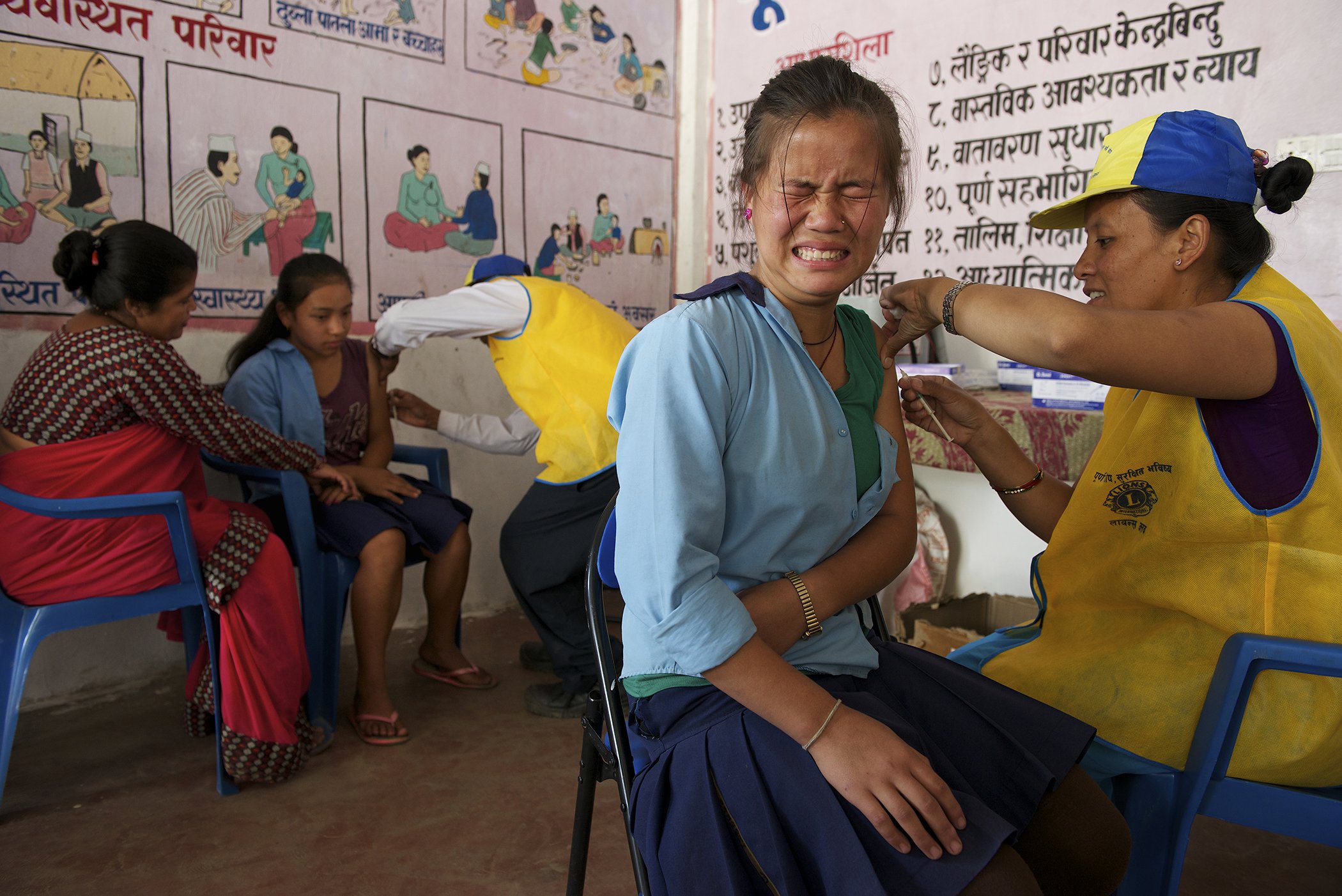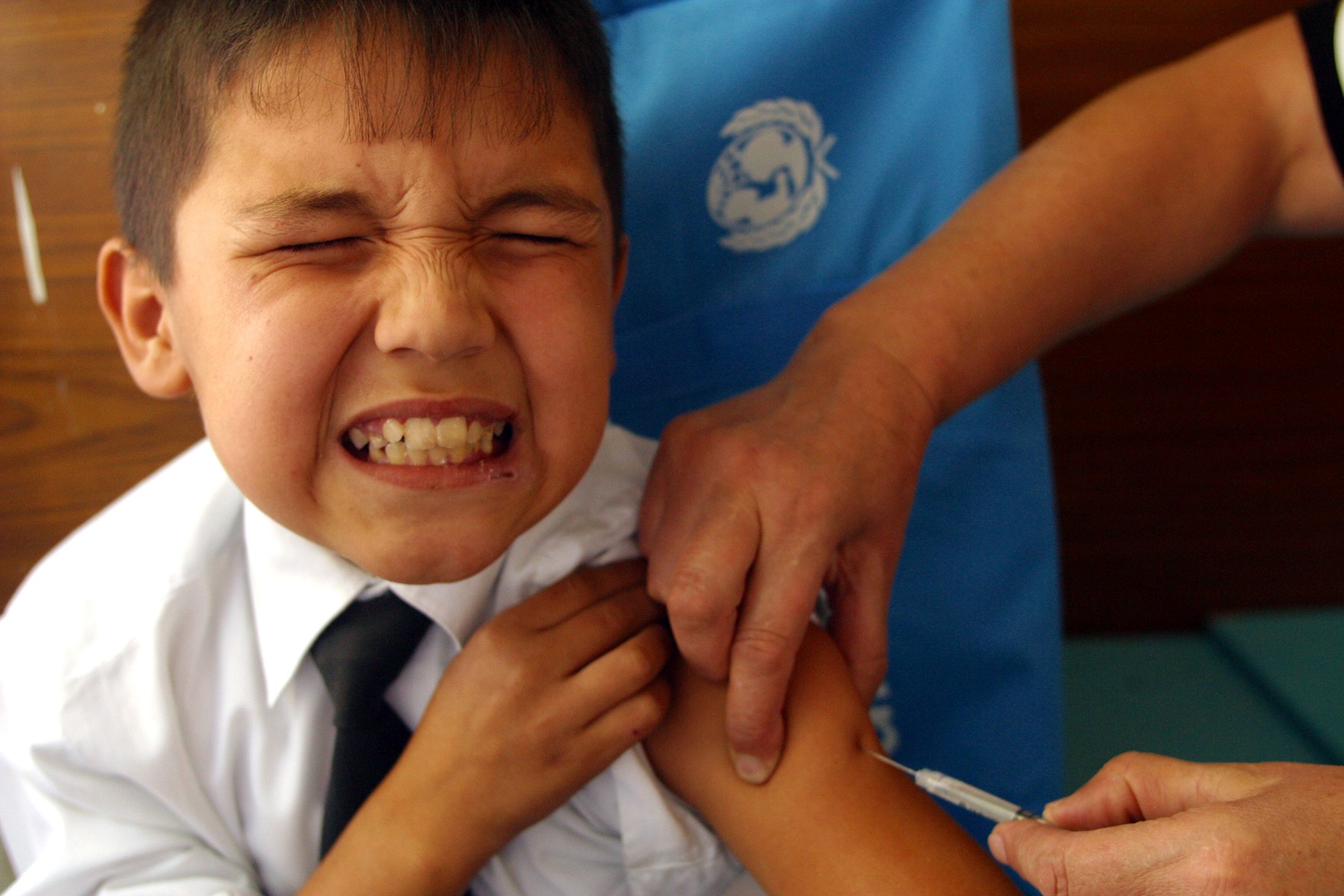No one enjoys having a needle stuck in their arm — as these photographs clearly show. But vaccinations are more than worth a couple of seconds of pain.
Immunization saves up to 3 million lives every year, by protecting us from diseases like measles, polio, yellow fever, tetanus, cholera, diphtheria, and influenza. More than 1.9 billion children around the world were vaccinated by the UN’s children agency UNICEF between 2000 and 2016.
But still, millions of young children around the world are missing out.
Take Action: Where You Live Shouldn’t Decide Whether You Live. Demand World Leaders Invest in Vaccines
In 2016, a quarter of all deaths among children under five were because of pneumonia, measles, and diarrhoea. Tragically, most could have been prevented by a simple vaccination — at a cost of often less than $1.
Around 19.5 million infants a year aren’t fully immunized, according to UNICEF. And of those children that are missing out, two-thirds live in areas affected by conflict.
Here’s what UNICEF’s life-saving vaccination work around the world looks like.
 Dr. Cesar Palma and Nurse Shanti deVries vaccinate a girl, at Pieter Boer School in Oranjestad, the capital of Aruba. Between 2000 and 2016, UNICEF worked with governments and partners to vaccinate more than 1.9 billion children around the world. Coverage is very high in Aruba, thanks to its universal health care program.
Dr. Cesar Palma and Nurse Shanti deVries vaccinate a girl, at Pieter Boer School in Oranjestad, the capital of Aruba. Between 2000 and 2016, UNICEF worked with governments and partners to vaccinate more than 1.9 billion children around the world. Coverage is very high in Aruba, thanks to its universal health care program.
Aruba: Dr. Cesar Palma and Nurse Shanti deVries vaccinate a girl, at Pieter Boer School in Oranjestad, the capital of Aruba in 2011. Between 2000 and 2016, UNICEF worked with governments and partners to vaccinate more than 1.9 billion children around the world. Coverage is very high in Aruba, thanks to its universal health care program.
 At a makeshift settlement for Rohingya refugees in Cox’s Bazar district, a child grimaces as he is administered a vaccine for diphtheria in December 2017.
At a makeshift settlement for Rohingya refugees in Cox’s Bazar district, a child grimaces as he is administered a vaccine for diphtheria in December 2017.
Bangladesh: At a makeshift settlement for Rohingya refugees in Cox’s Bazar district, a child grimaces as he is administered a vaccine for diphtheria in December 2017. The cost of a vaccine, often less than US $1, pales in comparison to the cost of treating a sick child or fighting a disease outbreak.
 A schoolgirl is administered a measles-rubella vaccine at an immunization site in Ghermu Village in 2012.
A schoolgirl is administered a measles-rubella vaccine at an immunization site in Ghermu Village in 2012.
Nepal: A schoolgirl is administered a measles-rubella vaccine at an immunization site in Ghermu Village in 2012. Between 2000 and 2016, the measles vaccine prevented more than 20 million deaths.
 An infant is vaccinated in a transit camp for people fleeing the civil war in Libya, at the Ras Jedir border post between Tunisia and Libya.
An infant is vaccinated in a transit camp for people fleeing the civil war in Libya, at the Ras Jedir border post between Tunisia and Libya.
Tunisia: An infant is vaccinated in a transit camp for people fleeing the civil war in Libya, at the Ras Jedir border post between Tunisia and Libya in 2011. Immunization in the midst of conflict and displacement is even more critical.
 Ten-year-old Mehrdod receives a measles vaccine in Dushanbe, Tajikistan. In 2016, one-fourth of all deaths among children under five were due to pneumonia, measles and diarrhea. Most of these deaths could have been prevented by vaccination.
Ten-year-old Mehrdod receives a measles vaccine in Dushanbe, Tajikistan. In 2016, one-fourth of all deaths among children under five were due to pneumonia, measles and diarrhea. Most of these deaths could have been prevented by vaccination.
Tajikistan: Ten-year-old Mehrdod receives a measles vaccine in Dushanbe in 2004. In 2016, one-fourth of all deaths among children under five were due to pneumonia, measles and diarrhea. Most of these deaths could have been prevented by vaccination.
 At a maternal and child health unit in Pazongo, a woman winces as she receives a tetanus vaccine.
At a maternal and child health unit in Pazongo, a woman winces as she receives a tetanus vaccine.
Uganda: At a maternal and child health unit in Pazongo, a woman winces as she receives a tetanus vaccine in 2010.
 A boy who lives on the streets is vaccinated in Chittagong in 2006.
A boy who lives on the streets is vaccinated in Chittagong in 2006.
Bangladesh: A boy who lives on the streets is vaccinated in Chittagong in 2006.
 A schoolgirl is immunized in Port-au-Prince during a nationwide vaccination campaign in 2007. 19.5 million infants a year are still not fully immunized, remaining vulnerable to illness, disability or death from vaccine-preventable diseases.
A schoolgirl is immunized in Port-au-Prince during a nationwide vaccination campaign in 2007. 19.5 million infants a year are still not fully immunized, remaining vulnerable to illness, disability or death from vaccine-preventable diseases.
Haiti: A schoolgirl is immunized in Port-au-Prince during a nationwide vaccination campaign in 2007. 19.5 million infants a year are still not fully immunized, remaining vulnerable to illness, disability or death from vaccine-preventable diseases.
 A girl winces while a health worker vaccinates her against measles and rubella at a school in Ulaanbaatar in 2012.
A girl winces while a health worker vaccinates her against measles and rubella at a school in Ulaanbaatar in 2012.
Mongolia: A girl winces while a health worker vaccinates her against measles and rubella at a school in Ulaanbaatar in 2012.
 In the town of Kiech Kon, Upper Nile State, a health worker administers a vaccination to a boy in 2014. Children living in conflict areas are the most vulnerable to diseases outbreaks.
In the town of Kiech Kon, Upper Nile State, a health worker administers a vaccination to a boy in 2014. Children living in conflict areas are the most vulnerable to diseases outbreaks.
South Sudan: In the town of Kiech Kon, Upper Nile State, a health worker administers a vaccination to a boy in 2014. Children living in conflict areas are the most vulnerable to diseases outbreaks.